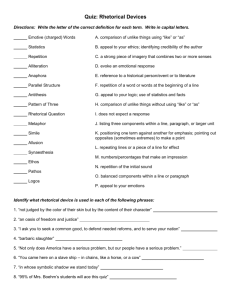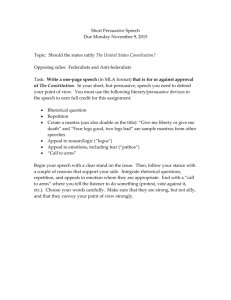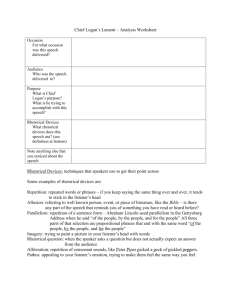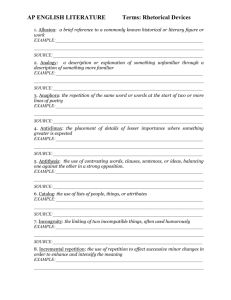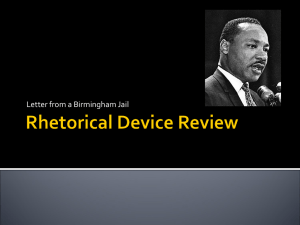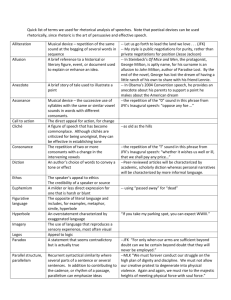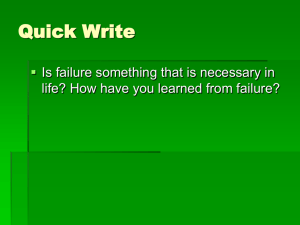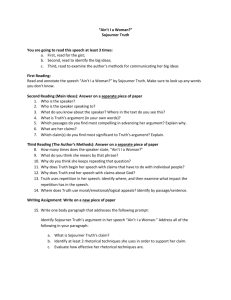Writing a persuasive piece - Union County Public Schools
advertisement
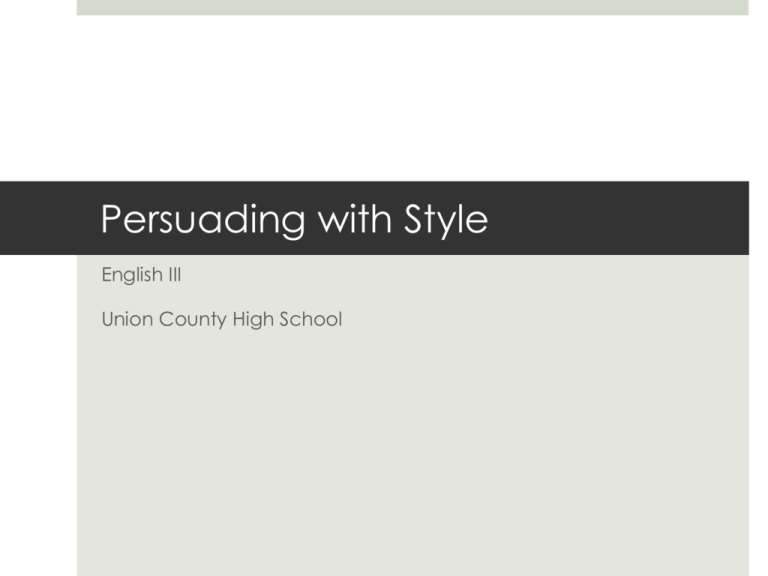
Persuading with Style English III Union County High School Friday, August 16, 2013 Jonathan Edwards “I think it is a reasonable thing to fright persons away from hell… Is it not a reasonable thing to fright a person out of a house on fire?” -Edwards Flashback: What do YOU think?! Jonathan Edwards… in a word (or several words) -entered Yale before 13 years old; -graduated first in his class; -son and grandson of Puritan ministers; -ordained a minster at 23; -soon became known for his “preaching of terror”; Jonathan Edwards… in a word (or several words) -believed God was all-powerful and humans had no free will; -preached that God had predestined people to go to heaven or hell (Calvinism); -eventually dismissed from his congregation; Jonathan Edwards… in a word (or several words) -helped trigger the Great Awakening—a religious revival that swept through New England from 1734-1750 -movement grew out of belief from ministers that congregations had grown too self-satisfied Persuasion in Sinners in the Hands of an Angry God Emotional Appeals -fear: taps into a fear of losing one’s safety and security -pity: draws on a sympathy or compassion for others -guilt: relies on one’s sense of ethics or morality Directions: In the chart, record examples of language used to appeal to the audience’s emotions. Stop and Identify Role Play -With a partner, take turns role playing a conversation with a child who has been stealing. Your mission is to persuade him or her to stop. Before you begin consider how best to keep the child in line. For example, you might frighten or shame the child or appeal to his or her pride. Monday, August 19, 2013 What’s the 4-1-1 on the FQ (fundamental question) What effect does tone have on persuasion? What effect does repetition have on persuasion? Think-Pair-Share Before we get started, think for a moment about a time when you’ve repeated yourself to your parents as you tried to persuade them to let you have your way. Once you have thought of an example, turn to a classmate sitting near you and share your experience. We’ll share as a class thereafter. Sojourner Truth -battled against slavery and in support of the rights of women -nearly six feet tall; had a deep, smooth voice that quieted rowdy crowds and won devoted supporters -born into slavery and endured cruel slave owners, backbreaking work, and harsh beatings -at 29, she escaped from slavery -took refuge with Isaac and Maria Van Wagener -changed her name to Isabella Van Wagener Sojourner Truth -at 46, she took the name Sojourner Truth -became a traveler preaching the truth of God -delivered “And Ain’t I a Woman” speech at the Akron, Ohio, Women’s Rights Convention in 1851 Wait… Here are a couple of literary terms that are good to know Tone: Repetition: A reflection of a writer’s or a speaker’s attitude toward the subject matter, as conveyed through elements such as word choice, punctuation, sentence structure, and figures of speech. The recurrence of sounds, words, phrases, lines, or stanzas in a speech or piece of writing. Repetition increases the sense of unity in a work and can call attention to particular ideas. “And Ain’t I a Woman?” Now, compare these two versions of Truth’s speech “And Ain’t I a Woman?” Version One Version Two After viewing the two videos, briefly discuss with a partner how the variations in tone affect the overall meaning of the speech. STOP! A reminder of our learning targets: Compare tone from two versions of “And Ain’t I a Woman?” Analyze the effect of repetition on persuasion Before you leave…. Tear and share: On 1/2 sheet of paper, describe the persuasive effort of Truth’s repetition Tuesday, August 20, 2013 What’s the 4-1-1 on the FQ (fundamental question) What effect do the rhetorical devices in Henry’s speech have on the persuasion of what he’s saying? Webbing Draw a circle. In that circle, write figures of speech. Draw smaller circles branching from the center one. In those circles, brainstorm as many figures of speech as you can think of. Patrick Henry -AKA “the Orator of Liberty” -supported American democracy -against British rule in the American colonies -”Speech in the Virginia Convention”— convinced the assembled leadership to prepare for war with Britain -helped write the new state constitution and the Virginia Declaration of Rights—major influence on the Bill of Rights added to the US Constitution Patrick Henry --offered the post of secretary of state and supreme court justice; declined both because of suspicions of the feds -had 16 children—six by wife number one, who died, and then 10 by wife number two -owned slaves -advocated the right to bear arms later guaranteed by the US Constitution -strongly supported states’ rights Wait… Here are several literary terms that are good to know Rhetorical devices are structures within language that appeal to readers or listeners and communicate ideas. A rhetorical question is a question to which no answer is expected. (But when shall we be stronger?) Antithesis expresses contrasting ideas in parallel grammatical structures. (Give me liberty, or give me death!) Wait… Here are several literary terms that are good to know Repetition is the recurrence of words, phrases, or lines. (Let it come! I repeat it, sir, let it come!) Biblical allusions are references to events, figures, or phrases from the Bible. In this selection, they have the rhetorical appeal of shared beliefs. STOP! A reminder of our learning targets: Recognize the effect of figures of speech on persuasion The Textbook Now, turn to page 147 and let’s begin reading “Speech to the Second Virginia Convention” Wednesday, August 21, 2013 Let’s review the literary terms we discussed yesterday . . . . Rhetorical devices are structures within language that appeal to readers or listeners and communicate ideas. A rhetorical question is a question to which no answer is expected. (But when shall we be stronger?) Antithesis expresses contrasting ideas in parallel grammatical structures. (Give me liberty, or give me death!) A little more of the review from yesterday . . . . Repetition is the recurrence of words, phrases, or lines. (Let it come! I repeat it, sir, let it come!) Biblical allusions are references to events, figures, or phrases from the Bible. In this selection, they have the rhetorical appeal of shared beliefs. Find those terms in Henry’s speech. To the text!
